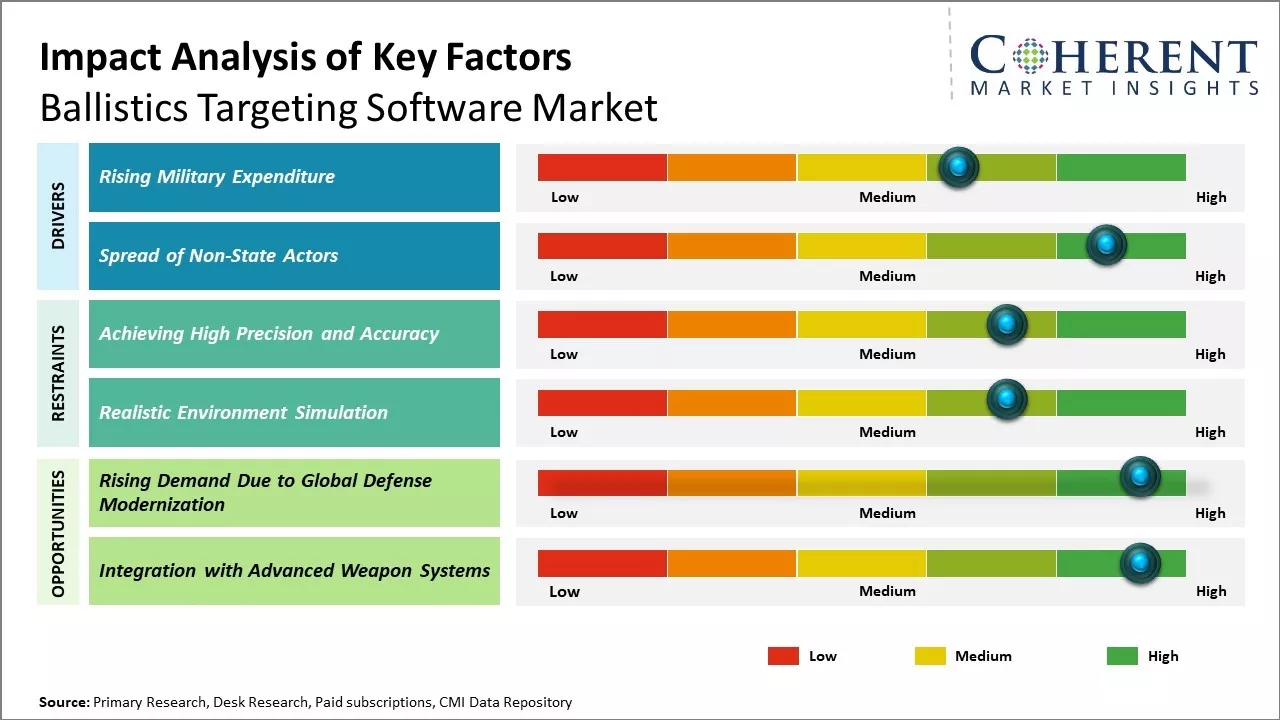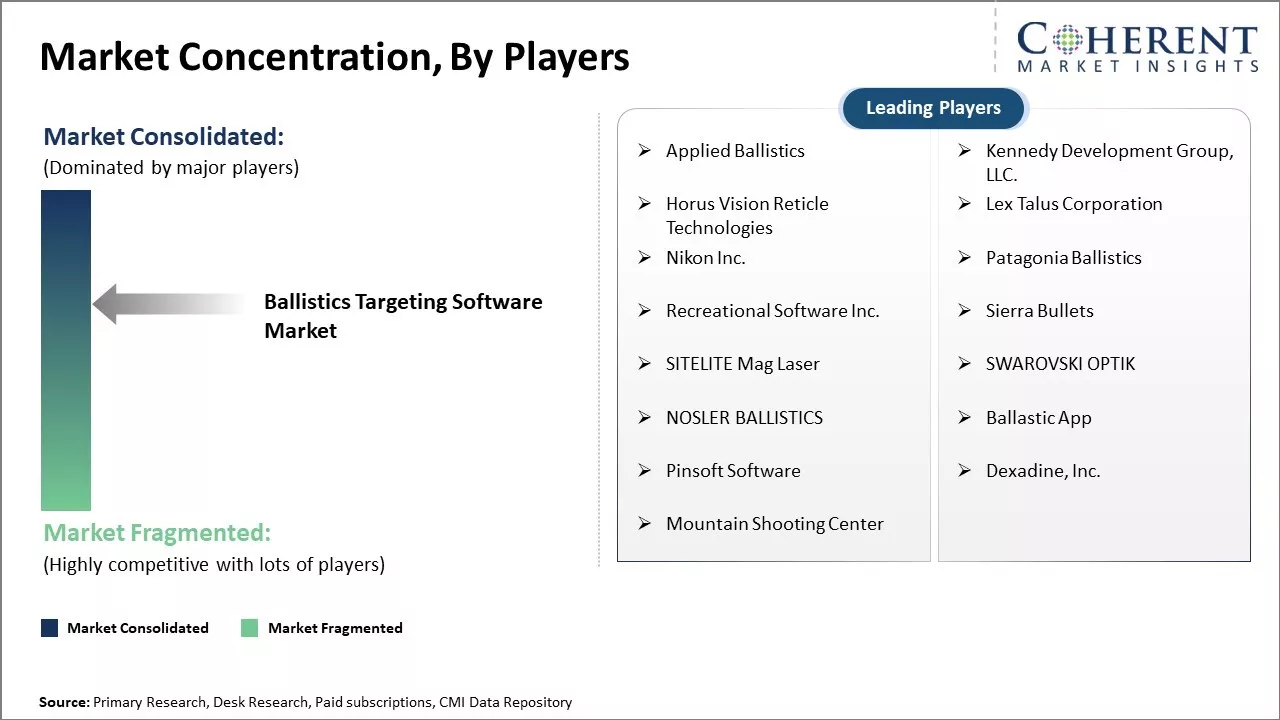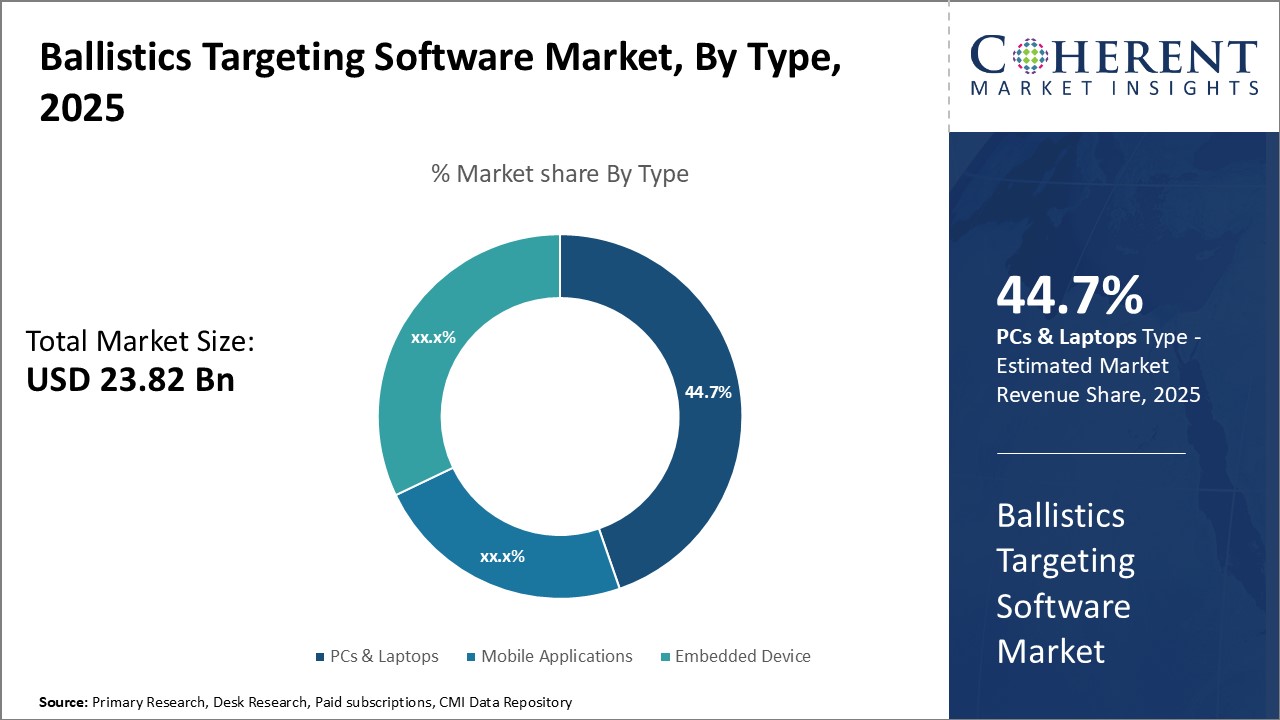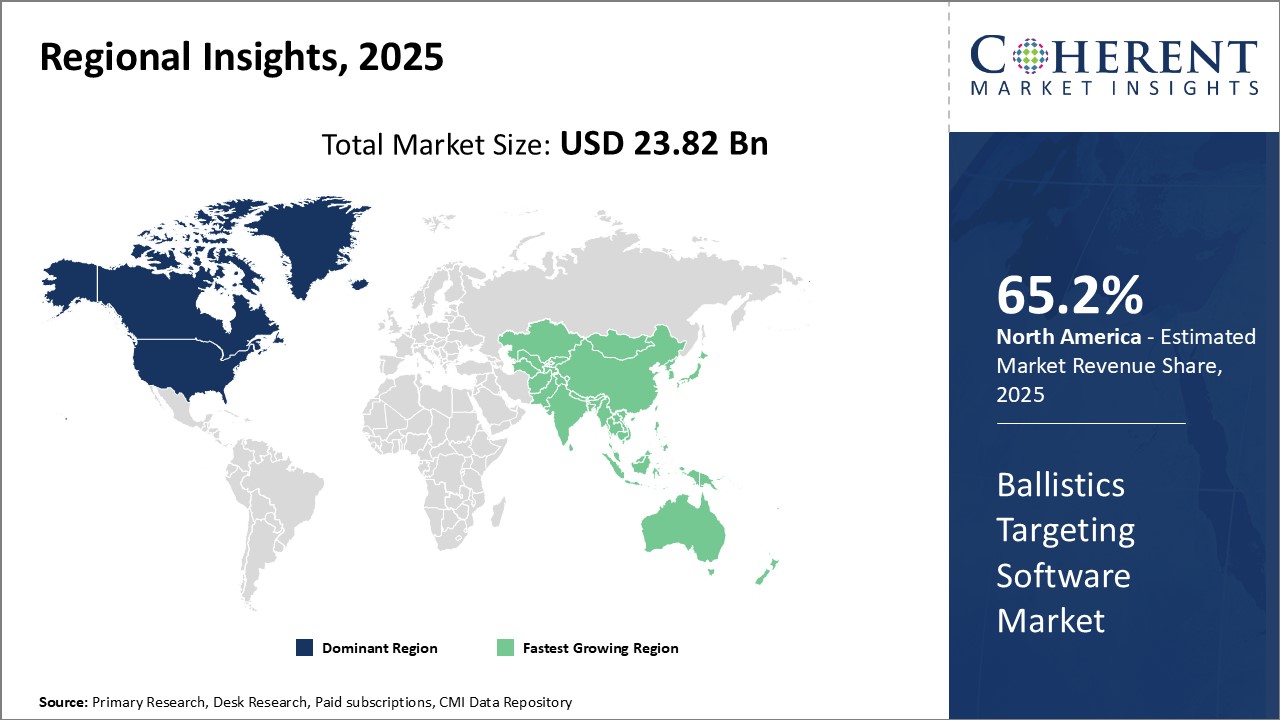Ballistics Targeting Software Market Size and Trends
The Ballistics Targeting Software Market is estimated to be valued at USD 23.82 billion in 2025 and is expected to reach USD 44.13 billion by 2032, growing at a compound annual growth rate (CAGR) of 9% from 2025 to 2032.

Discover market dynamics shaping the industry: Download Free Sample
The ballistics targeting software market is driven by increasing defense budgets of major economies and the rising adoption of ballistics software in training simulations. Ballistics targeting software helps militaries integrate ballistic calculations into their training and combat operations by simulating weapon trajectories and environmental factors. There is growing demand for accurate ballistic simulations to plan defense strategies, calibrate weapons systems, and train personnel. The development of advanced ballistic targeting algorithms is allowing software to model more complex real-world conditions. Major players are also incorporating augmented reality and virtual reality into their software to improve usability and training effectiveness.
Rising Military Expenditure
The demand for ballistics targeting software is expected to increase significantly over the coming years due to rising military expenditure across both developed and developing nations. Many countries are modernizing their armed forces and weapon systems which requires sophisticated targeting capabilities. Ballistic targeting solutions help optimize resource utilization and improve combat effectiveness. With geo-political tensions on the rise, most governments are allocating higher budgets to boost national security. Countries want their military units, aircraft, naval vessels and missiles integrated with best-in-class targeting software. This driver indicates strong and sustained demand from the defense sector.
Market Concentration and Competitive Landscape

Get actionable strategies to beat competition: Download Free Sample
Spread of Non-State ActorsAnother key factor augmenting the ballistics targeting software market is the spread of non-state actors and asymmetric warfare. Insurgent groups, terrorist networks and militia forces do not have the wherewithal to procure advanced military hardware on their own. However, they possess small arms and continue to pose challenges to governments. This has increased the utilization of ballistics targeting algorithms in weapons used by police, paramilitary and special forces units deployed against such threats. Compact targeting solutions assist security operations in diverse landscapes. Their mounting use against evolving new threats will proceed to support the software market. The complexity of modern conflicts means demand will remain buoyant from security agencies as well to tackle diverse emerging dangers.
Key Takeaways of Analyst:
The ballistics targeting software market is poised to grow substantially in the coming years. Key drivers of growth will be increasing defense budgets globally and modernization of armed forces with advanced weapons and platforms. Additionally, rising threats of terrorism will push militaries to invest in precision targeting capabilities. On the technology front, advancements in artificial intelligence, virtual/augmented reality, and predictive analytics are expected to make ballistics software more autonomous and effective.
However, high initial costs of upgrading existing systems with new targeting solutions may restrain quicker adoption. Geopolitical tensions could also impact defense spending cycles of some nations. Additionally, the nature of defense procurement being complex with lengthy purchase processes poses challenges.
The North American region currently dominates the market and is expected to continue its leadership. Growing Indo-Pacific tensions will drive opportunities in this region with countries like India rapidly modernizing their weaponry. Europe is also upgrading capabilities to strengthen NATO amidst threats. Middle Eastern countries are investing heavily in border protection and counter-terrorism capabilities.
In summary, while ballistics targeting software fulfills a critical operational need, constraints around budgets and procurement cycles will determine the pace of growth. Technologies enhancing automation and integrating diverse data sources could help address client needs better. Both mature and emerging markets offer opportunities albeit with different adoption curves.
Market Challenges: Achieving High Precision and Accuracy
There are several challenges currently faced by the ballistics targeting software market. Developing software with high precision and accuracy is difficult given the chaotic nature of projectile trajectories. Other issues include properly simulating realistic environments and accounting for all external conditions that can impact targeting. Additionally, gaining widespread adoption of such specialized software requires extensive education of potential users.
Market Opportunities: Rising Demand Due to Global Defense Modernization
As defense modernization initiatives gain momentum worldwide, demand is growing for virtual and augmented targeting tools. Integration of software with advanced weapon systems also provides a key opportunity. Further opportunities lie in customizing products for varied ranged weapons and terrains. As simulation and automation become increasingly important in defense, ballistics targeting software can experience expanded usage across training and feasibility analysis.

Discover high revenue pocket segments and roadmap to it: Download Free Sample
In terms of By Type, PCs & Laptops contributes the highest share of 44.7% in 2025, owning to their versatility and customizability
PCs and laptops have long been the preferred platform for ballistics targeting software due to their versatility and ability to be customized. As the most widely used computing devices, PCs and laptops provide shooters and hobbyists with a familiar environment to analyze ballistics data and model different shooting scenarios. Their large high-resolution screens are ideal for reviewing intricately detailed ballistics charts, trajectories, external factors, and more.
PCs and laptops also allow for more advanced customization compared to other devices. Users can upgrade components like processors, graphics cards, and storage to keep machines powerful as software becomes more resource-intensive over time. Customizable accessories also expand functionality, like attaching additional monitors to see more views simultaneously. Upgradable hardware keeps PCs and laptops relevant for long-term use of evolving ballistics programs.
The open architecture of PCs and laptops further empowers customization at the software level. Users can install a variety of supplemental programs alongside primary ballistics software to enhance the shooting experience. Examples include weather monitoring utilities, rifle profiling apps, long-range camera tools, and artillery calculation assistants. This level of customization simply isn't possible on more closed hardware platforms.
Access to a wide assortment of input and output peripherals also contributes to why PCs and laptops dominate. Shooters regularly pair systems with specialty barometers, anemometers, chronographs, and other specializes sensors to capture detailed atmospheric and firing data. PCs and laptops also support advanced items like motion simulator hardware, virtual reality headsets, and 4K video capture for unparalleled accuracy training simulations.
In summary, the unmatched versatility, upgradability, customizability, and compatibility of the open PC and laptop platforms make them irreplaceable for serious ballistics software users. Their leading market share is well deserved.
In terms of By Applications, Professional Shooters contributes the highest share of 48.43% in 2025, as Professional Shooters rely on ballistics software for competitive advantages
For professional shooters in fields like long-range competitive shooting sports or law enforcement, having access to the most sophisticated ballistics software available can directly impact success and safety. These professionals need to ruthlessly optimize every variable to gain any minute competitive advantage or have the best tools for dangerous situations in the line of duty.
Ballistics software allows pros to extensively map out ballistics for their firearms under an endless combination of environmental and positional scenarios. Models can account for precise bullet types, barrels, weather on the day of a match, specific latitude/altitude, even temporary accessories. Marginally better estimates for trajectory and impact could mean the difference between first and second place.
Professionals also depend on ballistics programs to provide real-time updates on how environmental shifts like wind speed changes will dynamically affect shots. A graphical representation of how conditions impact bullet drop and flight on a laptop screen is critical for rapid adjustments in the heat of high-stakes competitions.
For law enforcement, being able to run “what if” simulations in different hostage situations or under unpredictable shooter barricade scenarios could save lives. Officers can use software to virtually test strategies before exposing themselves to real danger. The margin for error is zero, making top-tier precision a necessity over consumer-grade estimates.
In all, competitive advantages, enhanced safety, reliable real-time updates, and robust “what if” modelling make specialized professional-grade ballistics software indispensable for shooters at the highest levels. It fuels success, medal counts, and has protective applications as well.
Regional Insights

Need a Different Region or Segment? Download Free Sample
North America has established itself as the dominant region in the ballistics targeting software market with the share of 65.2% in 2025. The region is home to several major defense companies that are engaged in the development and integration of ballistic targeting systems across land, air, and naval platforms. These companies invest heavily in R&D to develop advanced simulation and training software for the armed forces. In addition, the regional militaries, especially the United States, spend huge amounts on military modernization programs that include new targeting systems. This stable demand from both commercial and government customers has enabled prominent software players to establish large customer bases in the region.
Apart from strong demand drivers, the region also has a highly skilled workforce with expertise in defense technologies. Many software developers are located within proximity to defense prime contractors and military bases, allowing for close collaboration. This proximity has helped North American companies accelerate product development and customization according to customer needs. Regional leadership in defense technologies coupled with a supportive policy environment has ensured sustained growth prospects for ballistic targeting software developers over the long term.
Among developing regions, Asia Pacific is emerging as the fastest growing market. Countries such as China, India, and South Korea are aggressively bolstering their military capabilities, with a focus on developing indigenous defense industries. Consequently, demand for ballistic targeting simulation and training solutions is increasing at a rapid pace from the region's armed forces as well as new entrants in the defense sector. Additionally, growing geopolitical tensions have raised concerns around national security across Asia Pacific, acting as a demand driver. Software developers view the region as a lucrative new market and are actively pursuing partnerships and customer acquisitions to gain a foothold early. The market remains largely untapped with ample headroom for growth in the coming years.
Market Report Scope
Ballistics Targeting Software Market Report Coverage
| Report Coverage | Details | ||
|---|---|---|---|
| Base Year: | 2024 | Market Size in 2025: | USD 23.82 Bn |
| Historical Data for: | 2020 To 2024 | Forecast Period: | 2025 To 2032 |
| Forecast Period 2025 to 2032 CAGR: | 9.2% | 2032 Value Projection: | USD 44.13 Bn |
| Geographies covered: |
|
||
| Segments covered: |
|
||
| Companies covered: |
Applied Ballistics, Kennedy Development Group, LLC. , Horus Vision Reticle Technologies, Lex Talus Corporation, Nikon Inc., Patagonia Ballistics, Recreational Software Inc., Sierra Bullets, SITELITE Mag Laser, SWAROVSKI OPTIK, NOSLER BALLISTICS, Ballastic App, Pinsoft Software, Dexadine, Inc., Mountain Shooting Center |
||
| Growth Drivers: |
|
||
| Restraints & Challenges: |
|
||
Uncover macros and micros vetted on 75+ parameters: Get instant access to report
*Definition: The ballistics targeting software market comprises companies that develop software programs used to analyze and predict the trajectory of projectiles like bullets and artillery shells. This type of software takes into account factors such as ballistic coefficients, meteorological conditions, firing solution, and point of impact to help shooters accurately hit targets at varying distances on land or sea. Ballistics targeting programs are used by military forces, law enforcement agencies, professional competitive shooters, and hunting enthusiasts.
Market Segmentation
- Type Insights (Revenue, USD Bn, 2020 - 2032)
- PCs & Laptops
- Mobile Applications
- Embedded Device
- Applications Insights (Revenue, USD Bn, 2020 - 2032)
- Professional Shooters
- Hunters
- Military Services
- Regional Insights (Revenue, USD Bn, 2020 - 2032)
- North America
- U.S.
- Canada
- Latin America
- Brazil
- Argentina
- Mexico
- Rest of Latin America
- Europe
- Germany
- U.K.
- Spain
- France
- Italy
- Russia
- Rest of Europe
- Asia Pacific
- China
- India
- Japan
- Australia
- South Korea
- ASEAN
- Rest of Asia Pacific
- Middle East & Africa
- South Africa
- GCC Countries
- Israel
- Rest of Middle East & Africa
- North America
- Key Players Insights
- Applied Ballistics
- Kennedy Development Group, LLC.
- Horus Vision Reticle Technologies
- Lex Talus Corporation
- Nikon Inc.
- Patagonia Ballistics
- Recreational Software Inc.
- Sierra Bullets
- SITELITE Mag Laser
- SWAROVSKI OPTIK
- NOSLER BALLISTICS
- Ballastic App
- Pinsoft Software
- Dexadine, Inc.
- Mountain Shooting Center
Share
Share
About Author
Suraj Bhanudas Jagtap is a seasoned Senior Management Consultant with over 7 years of experience. He has served Fortune 500 companies and startups, helping clients with cross broader expansion and market entry access strategies. He has played significant role in offering strategic viewpoints and actionable insights for various client’s projects including demand analysis, and competitive analysis, identifying right channel partner among others.
Missing comfort of reading report in your local language? Find your preferred language :
Transform your Strategy with Exclusive Trending Reports :
Frequently Asked Questions
EXISTING CLIENTELE
Joining thousands of companies around the world committed to making the Excellent Business Solutions.
View All Our Clients

